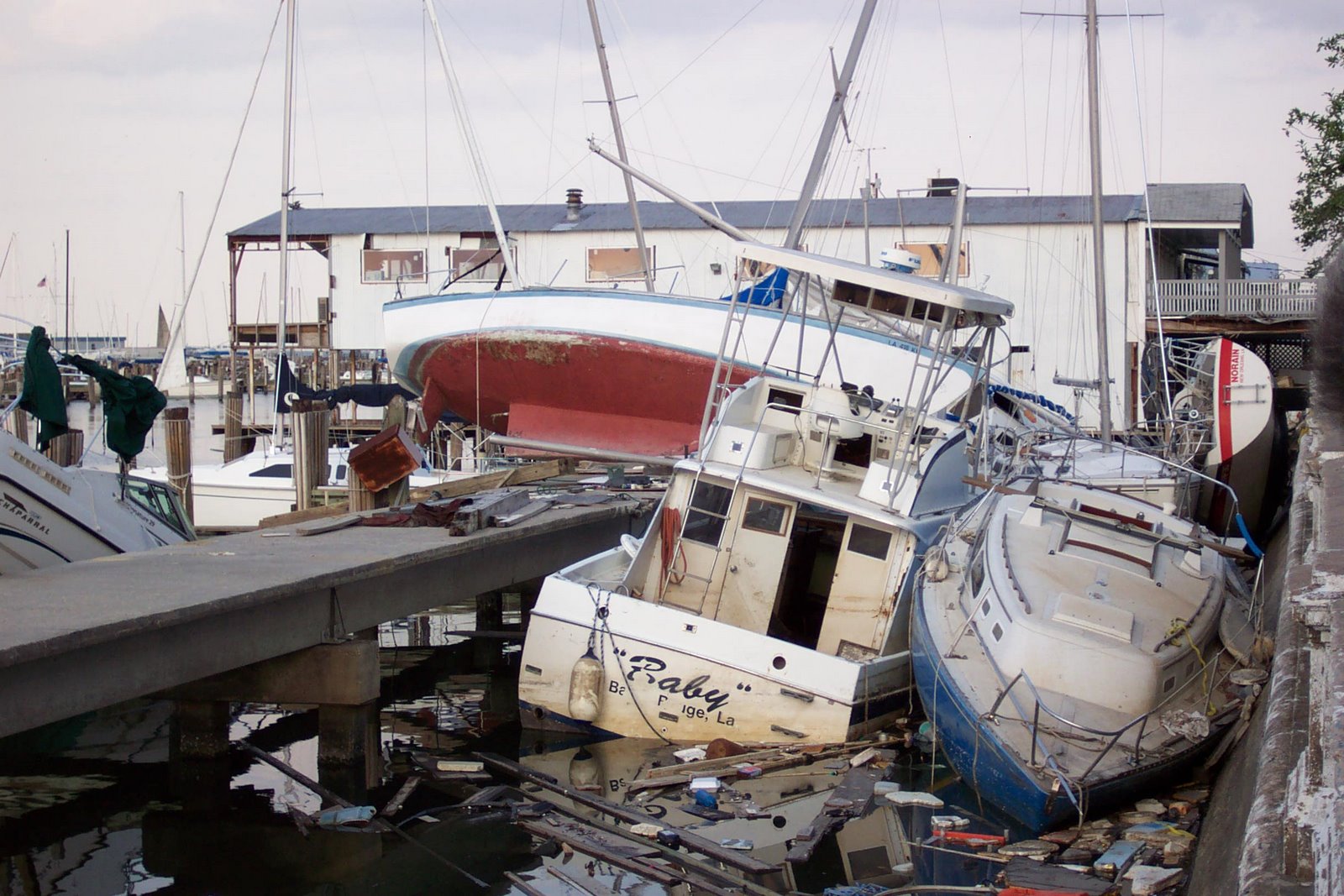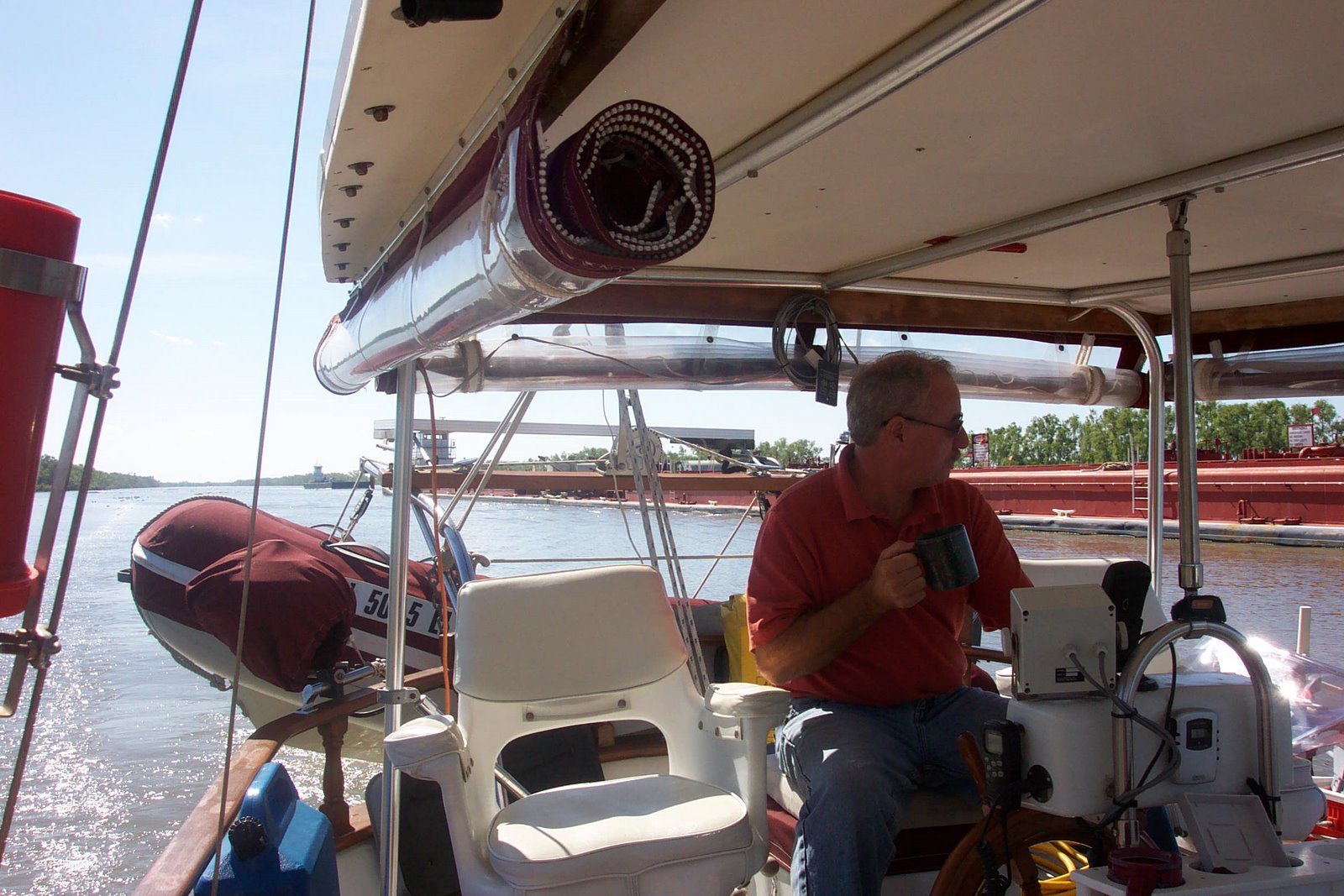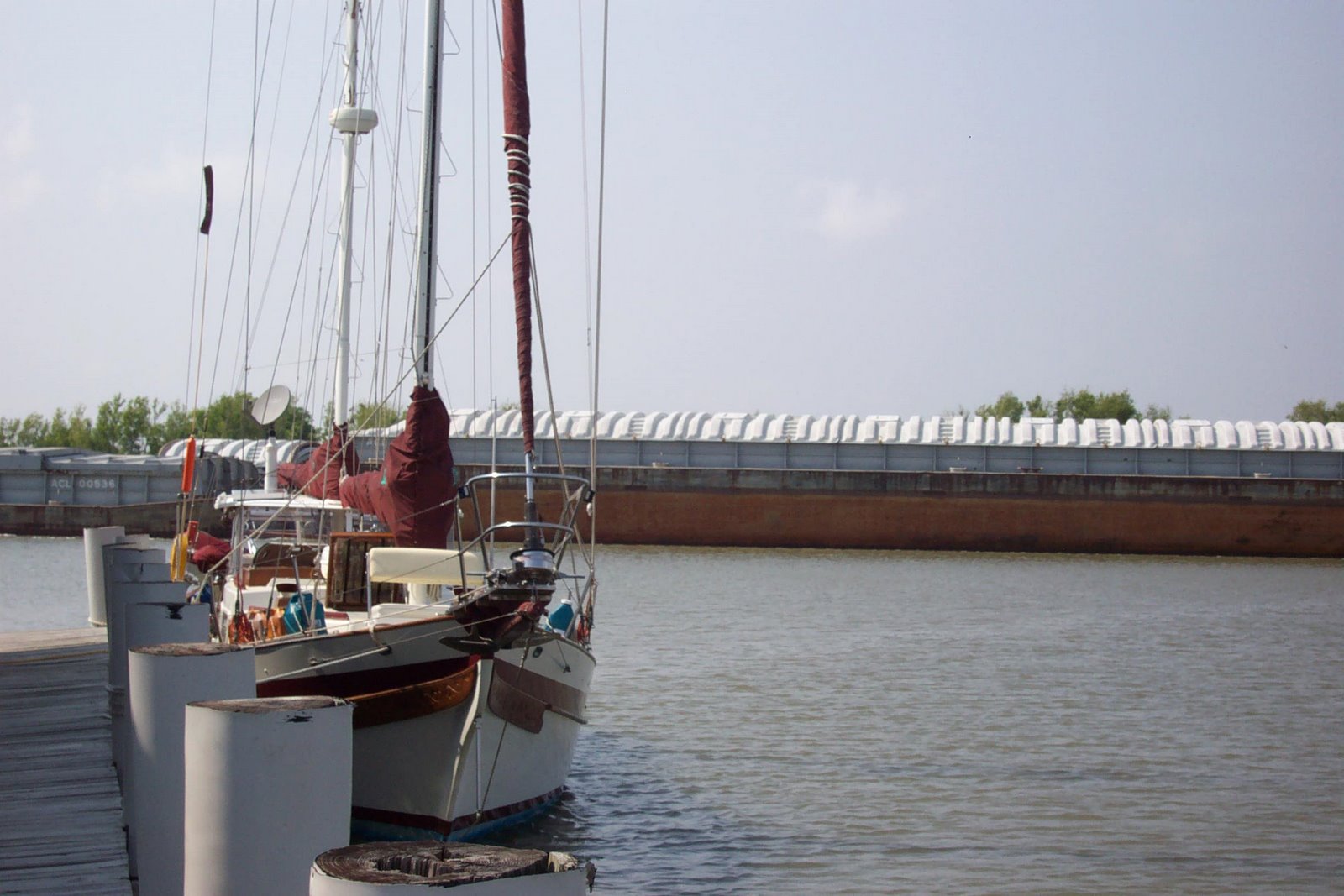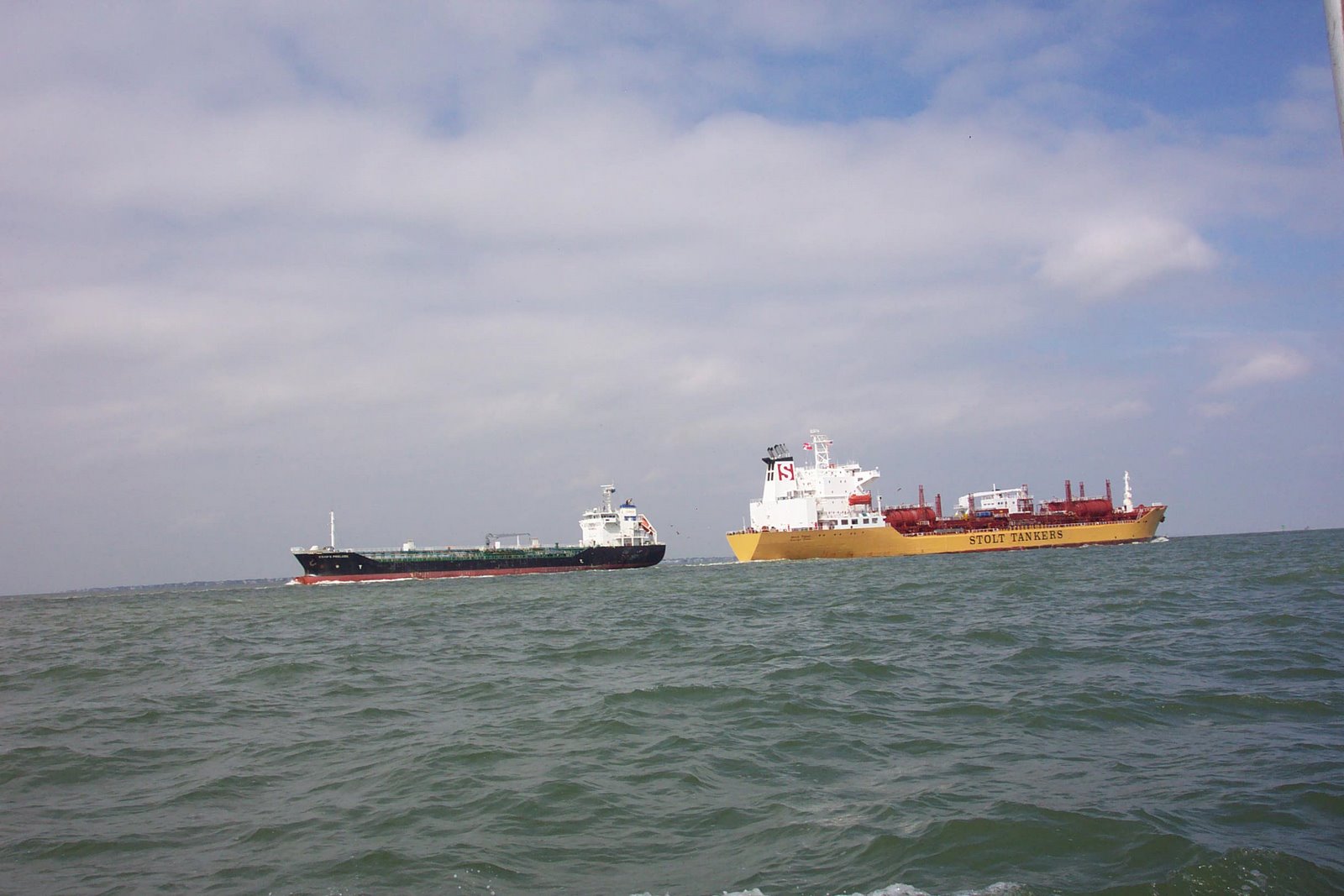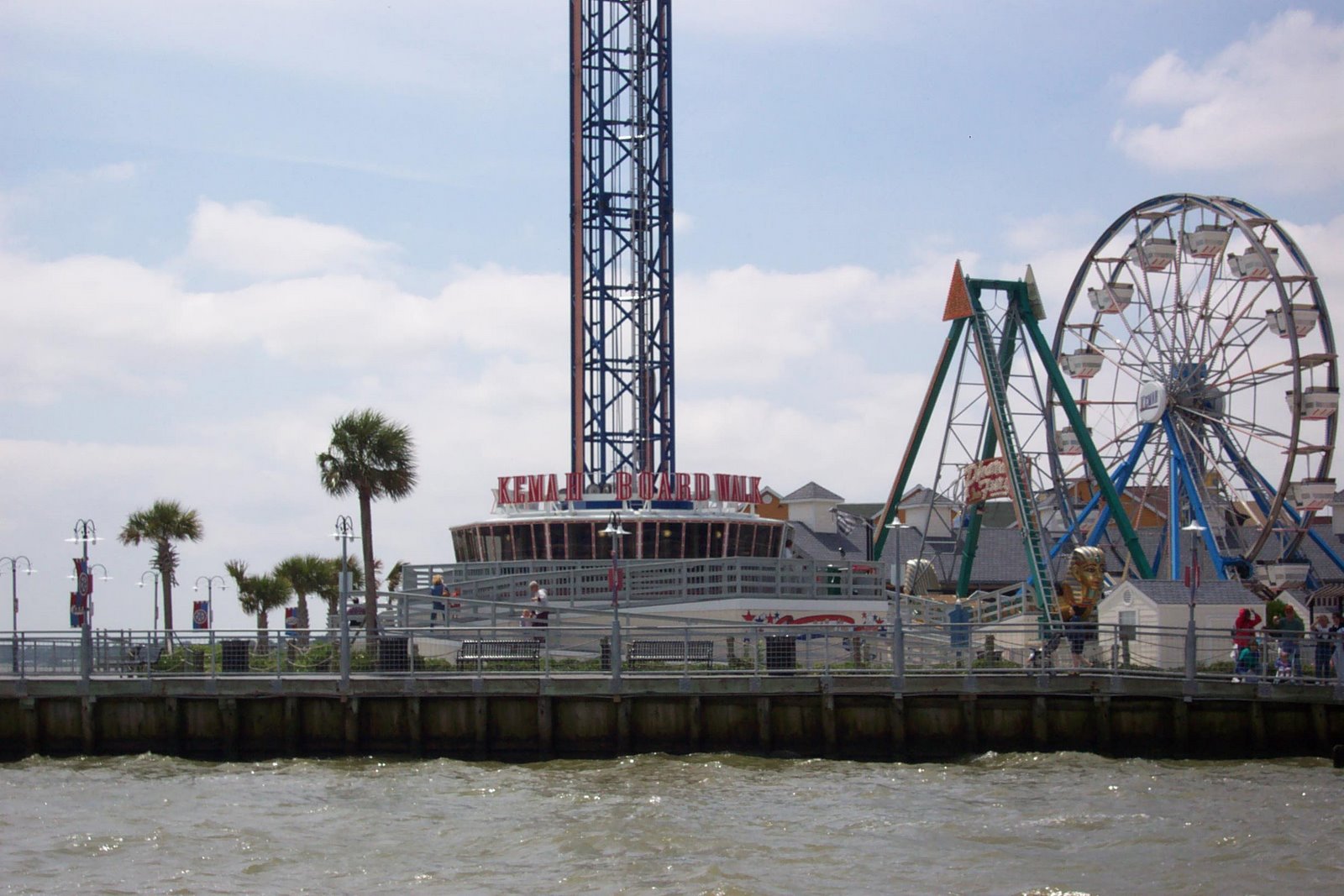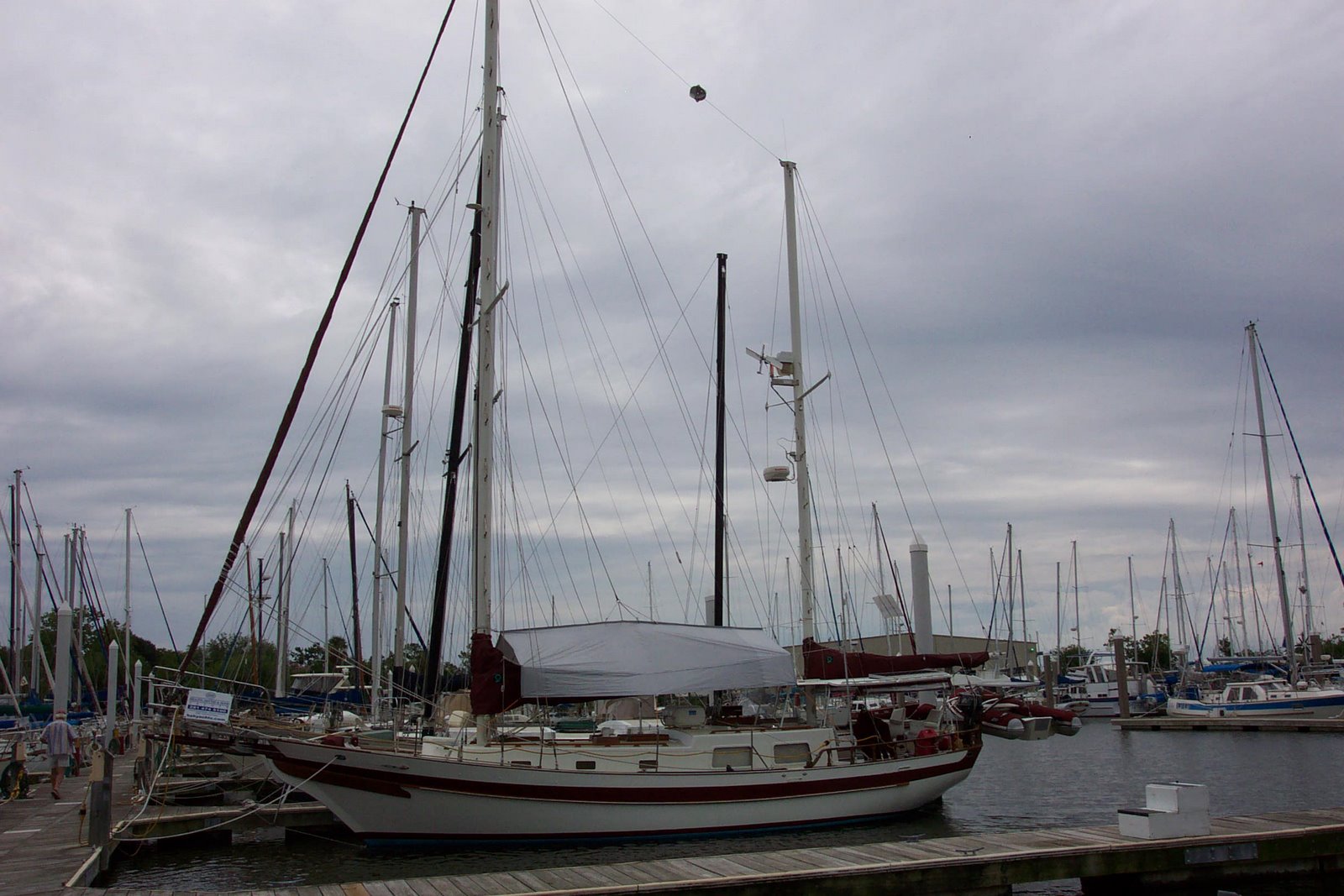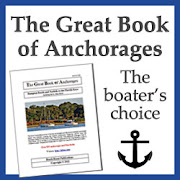 One of the tensest days of our entire trip began on a beautiful morning as we left our anchorage at Manasota Key. The day started with us aground after a tide shift moved us over a shallow spot and the tide dropped to mean low. With a short hour wait and a bit of maneuvering through the soft mud bottom, we were back in the channel and under way with only a minimum of inconvenience.
One of the tensest days of our entire trip began on a beautiful morning as we left our anchorage at Manasota Key. The day started with us aground after a tide shift moved us over a shallow spot and the tide dropped to mean low. With a short hour wait and a bit of maneuvering through the soft mud bottom, we were back in the channel and under way with only a minimum of inconvenience.
Ninety minutes later Sea Trek was transiting the Venice Avenue Bridge at Statute Mile 56.6 and we noticed what at first looked like smoke just beyond the bridge. As we crossed under the bridge and it was closing behind us we realized this was a fog bank and it was quickly getting denser.
This stretch of the Gulf Intracoastal Waterway is very shallow outside of the channel and we knew of no place Sea Trek could pull over and anchor with her 6-foot draft. So continuing on was our only option and we could only hope the fog would soon burn off as it usually did.
In situations like this we need every electronic weapon in our arsenal. Our radar becomes the most important piece of equipment on board. We immediately slowed to idle speed but had to keep the engine running to maintain forward movement, which made hearing other boats more difficult. We also use our laptop with an electronic chart program running to have a better handle on our exact position. But exact is not always the case with these programs and having it interfaced with the radar would have made a huge difference. I added this to the to-do list.
One of us stood watch on the foredeck with binoculars and we communicated with FSR radios, but the fog had quickly increased so we could hardly see from the bow to the stern. We used the radar to try and find the channel markers and the chart plotter to keep us heading in the direction of the channel.
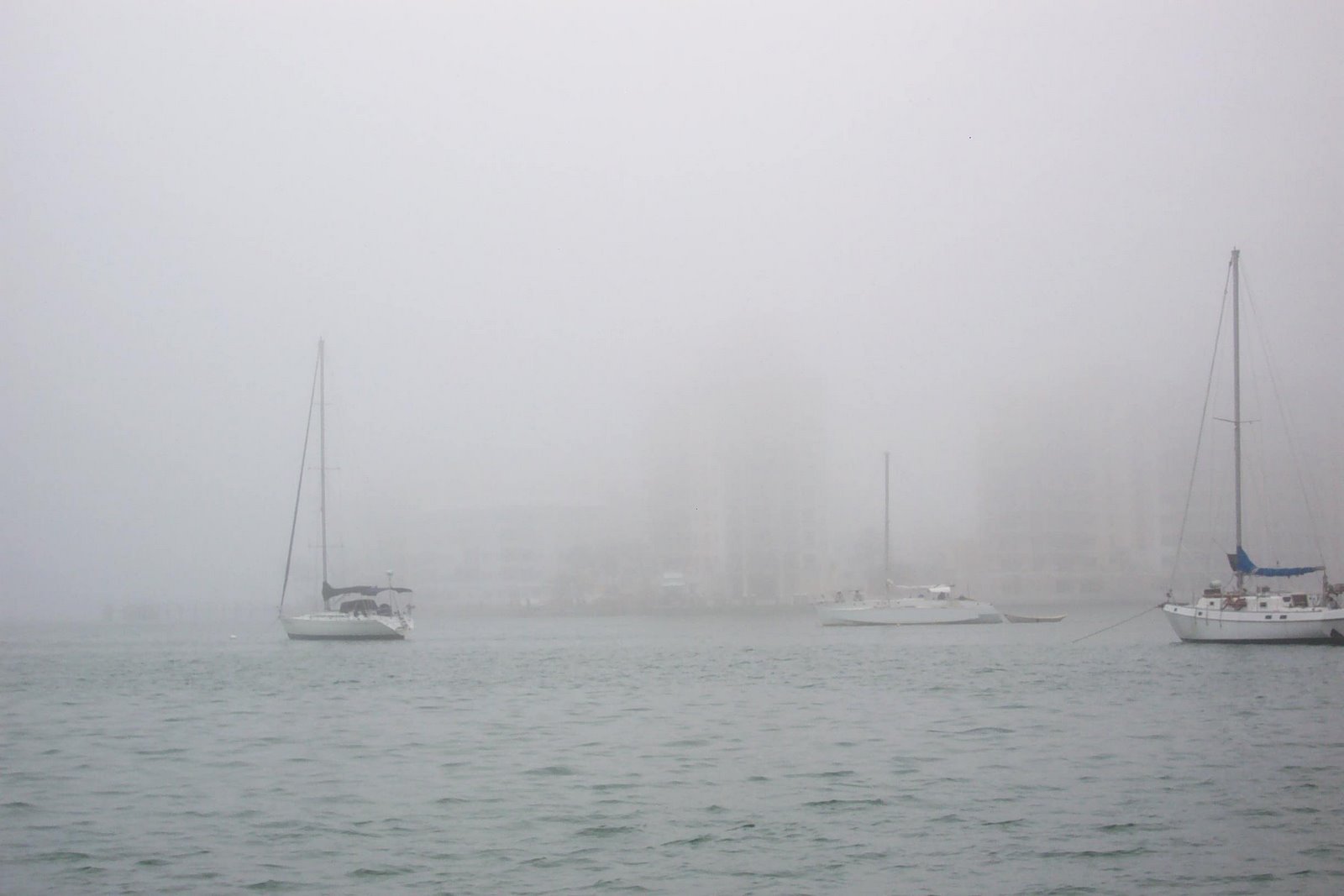 Soon several additional targets were picked up by radar, which turned out to be signs and abandoned pilings just outside of the channel in shallow water. Another problem soon popped up on the radar screen as a fast-moving target seemed to be heading straight for us. We came to a full stop and waited, and suddenly out of the fog came a small powerboat running what seemed to be far too fast for the conditions. This would happen to us several times in the next several hours and we were flabbergasted by their carelessness.
Soon several additional targets were picked up by radar, which turned out to be signs and abandoned pilings just outside of the channel in shallow water. Another problem soon popped up on the radar screen as a fast-moving target seemed to be heading straight for us. We came to a full stop and waited, and suddenly out of the fog came a small powerboat running what seemed to be far too fast for the conditions. This would happen to us several times in the next several hours and we were flabbergasted by their carelessness.The fog continued all day and we slowly picked our way from channel marker to channel marker using the radar and plotter. Careful monitoring of the depth sounder was essential and the day turned out to be a real nail-biter. We eventually arrived at the anchorage off downtown Sarasota and found a spot clear of what seems to be a community of permanently anchored vessels. It had been an exhausting day and feeling the anchor take hold and finally shutting down the engine we sat back and let the relief wash over us. A nice surprise was to find free Wi-Fi service for downtown Sarasota easily accessible on the boat.
The comfort of old friends
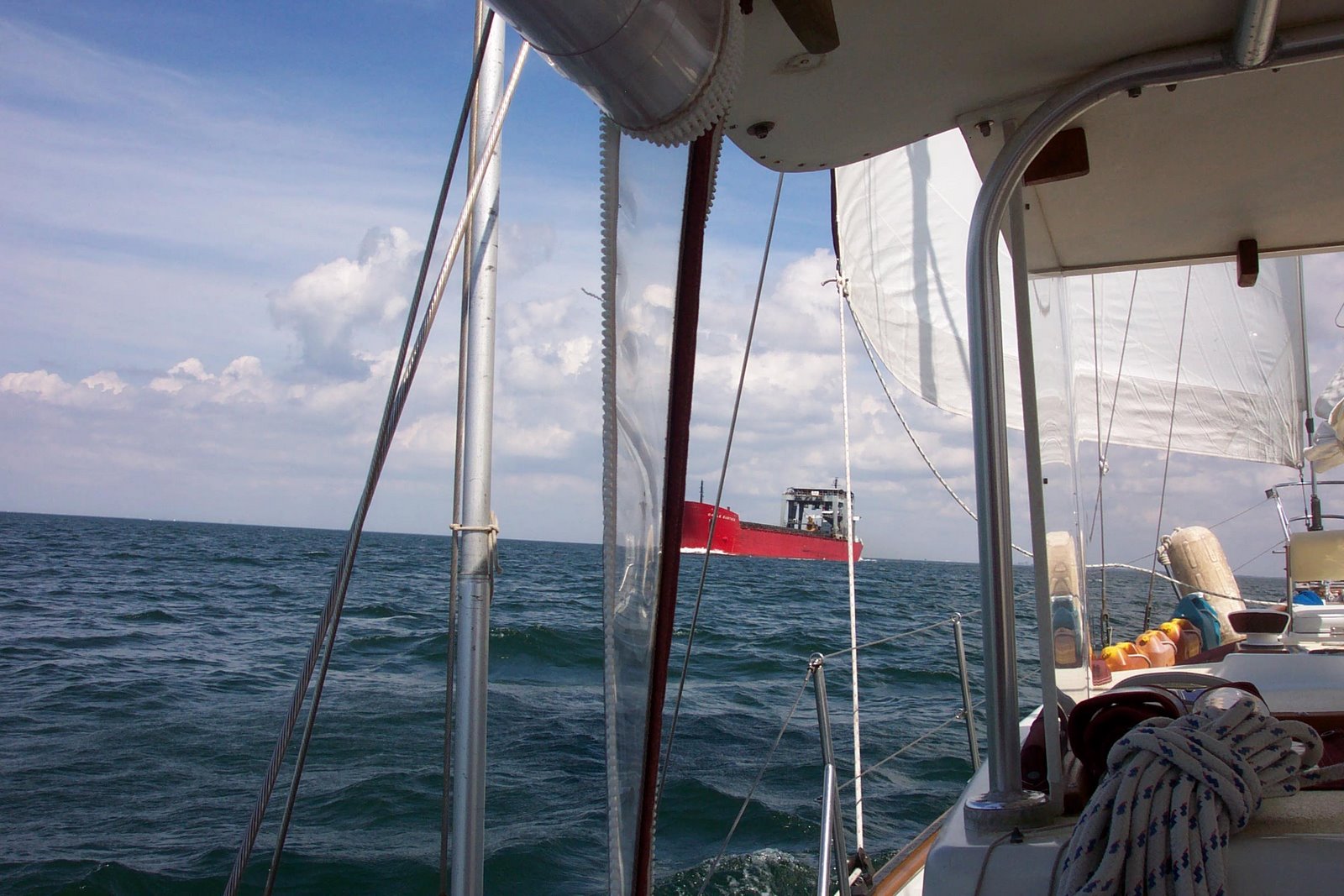 After a two-day rest we moved on to Ruskin off of Tampa Bay to visit some of our old cruising friends from the Bahamas and the Caribbean. The large marina in Ruskin was being converted to condos but one of our friends was a manager of the project and was able to arrange a slip for us. Our sail up the bay under the Sunshine Skyway Bridge was very relaxing after our previous experience.
After a two-day rest we moved on to Ruskin off of Tampa Bay to visit some of our old cruising friends from the Bahamas and the Caribbean. The large marina in Ruskin was being converted to condos but one of our friends was a manager of the project and was able to arrange a slip for us. Our sail up the bay under the Sunshine Skyway Bridge was very relaxing after our previous experience. It is always good to visit with old friends, especially fellow cruisers, and we had a wonderful visit. The three days went by fast, but we knew we needed to move on. We had other friends to visit just across the bay near St. Petersburg. A short 3-1/2-hour sail and we anchored once again just off the waterway behind Long Key.
The next day we moved to a dock behind our friend’s house.  The charts do not cover the depths in any of the canals in this area so we tiptoed in slowly and paid close attention to the depth sounder. As it turned out the canals were much deeper than the waterway itself and we had no problems. We had not seen our friends for many years so we had a lot of catching up to do. It was nice being tied to a private dock instead of a marina for a change. After another few days we untied the dock lines, said goodbye and headed out for our next stop which was Tarpon Springs.
The charts do not cover the depths in any of the canals in this area so we tiptoed in slowly and paid close attention to the depth sounder. As it turned out the canals were much deeper than the waterway itself and we had no problems. We had not seen our friends for many years so we had a lot of catching up to do. It was nice being tied to a private dock instead of a marina for a change. After another few days we untied the dock lines, said goodbye and headed out for our next stop which was Tarpon Springs. Our plan was to run the 30 miles to Anclote Island and anchor in the popular bay on the east side of the island. The weather forecast from the National Weather Service for the day would have made this a great sail and put us in the lee of the island — but this was not to be. The winds turned out  to be 15 to 20 on the nose and the anchorage we planned to use was exposed and rolley. We had heard of an anchorage just inside the Anclote River near a park and boat ramp so we decided to give it a try. We knew we could not make Tarpon Springs before nightfall and did not want to navigate the river at night.
to be 15 to 20 on the nose and the anchorage we planned to use was exposed and rolley. We had heard of an anchorage just inside the Anclote River near a park and boat ramp so we decided to give it a try. We knew we could not make Tarpon Springs before nightfall and did not want to navigate the river at night. The anchorage turned out to be deep enough, but is very narrow with no swinging room and a very busy boat ramp gave us incentive to be up and out early the next morning; but only after we waited for the tide to come up enough for us to power off the bar at the entrance.
We had a wonderful weeklong stay at the City Marina and enjoyed the sights, sounds and tastes of Tarpon Springs.
Bridges and shallows
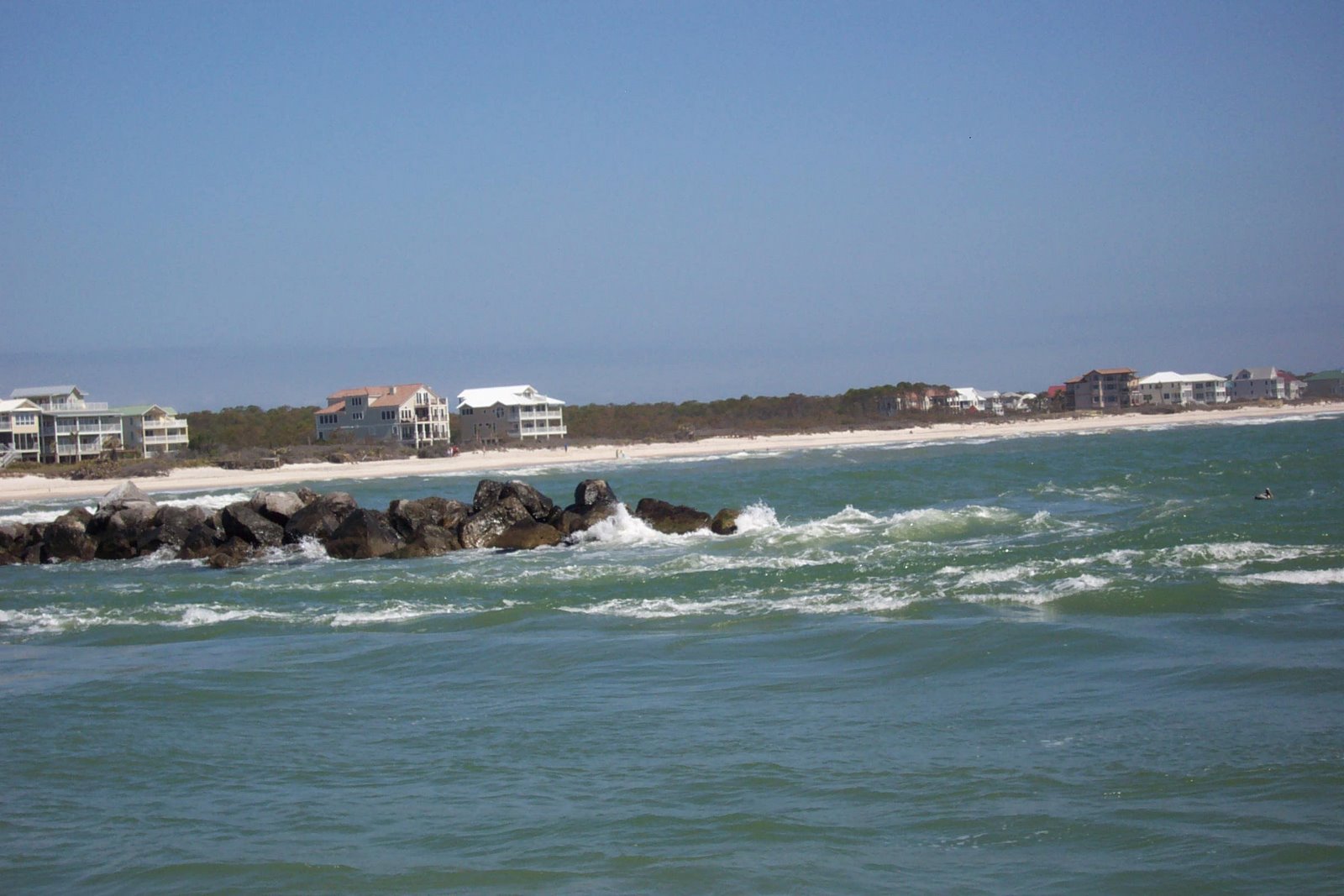 From Tarpon Springs to Carrabelle or Apalachicola, the trip is offshore into the Gulf of Mexico. Most skippers choose to either run along the coast just far enough offshore to avoid the shallow waters found in what is known as the Big Bend or make a direct run from Tarpon Springs to their destination. We chose the direct route to save mileage and time.
From Tarpon Springs to Carrabelle or Apalachicola, the trip is offshore into the Gulf of Mexico. Most skippers choose to either run along the coast just far enough offshore to avoid the shallow waters found in what is known as the Big Bend or make a direct run from Tarpon Springs to their destination. We chose the direct route to save mileage and time. The distance to Apalachicola across the Gulf is only seven miles longer than to Carrabelle, but if you make landfall at Carrabelle and take the inside route to Apalachicola it is 25 miles longer. There is also a 50-foot bridge on the inside route, which we could not pass under with Sea Trek’s 57-foot main mast. We went directly to Apalachicola and entered the Bay through St George’s Cut, more commonly known as Government Cut. All of our guide books told us this was a well-traveled deep cut used by commercial vessels.
As we entered the cut at half-tide, the depths went from 30 feet to 20 feet to 6 feet inside the cut with a very strong current. At 6 feet we were aground but Sea Trek has a wide full keel so grounding usually means we just park.
But there was also a pretty good swell running in from the Gulf since the winds had been out of the south for the previous few days. Each swell lifted us off the shallow bottom and pushed us a little farther through the cut until we were in deeper water. Fortunately Sea Trek is a well-built vessel and is completely unaffected by this kind of punishment as she has proven over the years. We would not recommend this for vessels of less sound construction and one should take care making this entrance.
Once completely through the cut we found 12 and 15 feet of water inside the bay and anchored behind St. Georges Island for the rest of the day and that night.
Early the next morning we hauled up anchor and moved up the channel to Apalachicola, where we had planned to do a quick haul out to check our zincs and the prop and running gear. We had not done this since Guatemala. It was routine maintenance for us and had nothing to do with the grounding.
The only facility in Apalachicola turned out to have a very small lift and after a brief attempt, we called off the haul out since it was obvious that it could not haul a boat the size and weight of Sea Trek.
The manager also informed us that this marina was being closed soon and torn down to make way for a condo complex. We heard this same story over and over again along the entire Florida coast.
Although there appeared to be some storm damage here, mainly to waterfront docks and restaurants, all marinas and fuel docks we encountered were open and operational.
Stopovers quiet and crowded
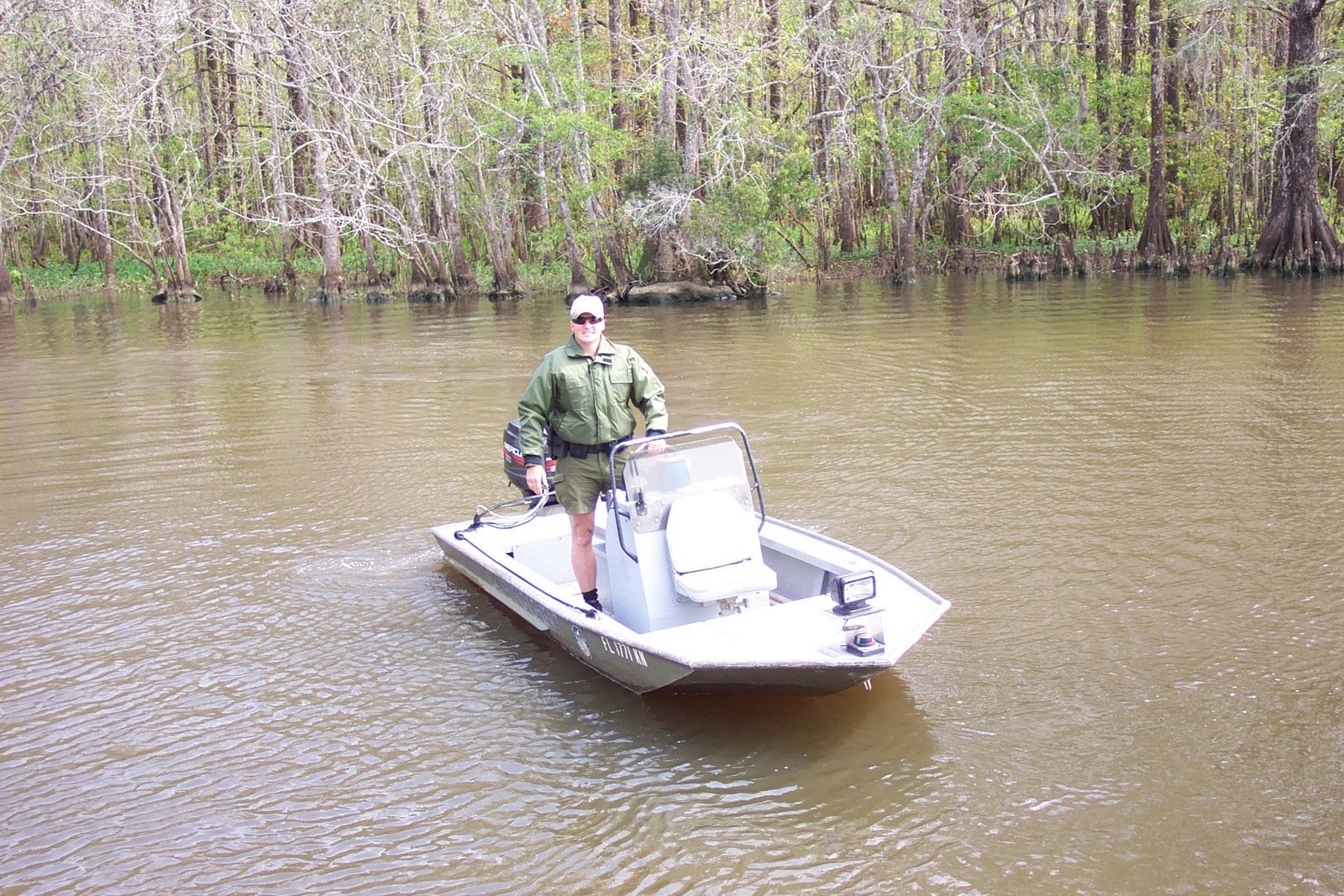 We continued along the waterway to Saul Creek, a small narrow tree-lined creek six or seven miles farther on. Here we spent a few days in quiet solitude, our only visitor a Fish and Wildlife Conservation Commission officer in his patrol boat, who stopped by for a friendly chat.
We continued along the waterway to Saul Creek, a small narrow tree-lined creek six or seven miles farther on. Here we spent a few days in quiet solitude, our only visitor a Fish and Wildlife Conservation Commission officer in his patrol boat, who stopped by for a friendly chat.From there we moved on only about 14 miles to White City, where there was a (according to our FWC officer) free tie-up at the town’s launch ramp.
The name White City is a bit misleading since we did find the free tie-up at a nice park setting with a small boat launching ramp. But there is no city, only a handful of private residences and a small convenience store about three-quarters of a mile from the park. The store mainly sells beer and soft drinks along with bait and snacks. They do have gas pumps, but do not sell diesel. You can leave trash and take on water at the dock.
From here we needed to re-enter the Gulf of Mexico as there are a few fixed 50-foot bridges along this section of the waterway that we cannot get under.
From our tie-up at White City, out to the Gulf by the five-mile-long Gulf County Canal and into the entrance at Panama City was only about 32 miles. After passing under the 65-foot bridge in Port St. Joe, we followed the deep ship channel out of St. Joseph’s Bay into the Gulf. From this point we stayed a few miles offshore and quickly arrived at the entrance to St. Andrews Bay. Upon entering the ship channel, Grande Lagoon to port is a favorite stopover here. The channel into Grande Lagoon has been recently dredged and channel markers installed. Entrance is easy, but be aware that boat traffic is very heavy.
As we entered the lagoon we noticed a number of vessels both power and sail still pushed up on the shoreline of the State Park on the south side of the bay. Boats were also sunk and sometimes upside-down outside the marked channel a bit farther in. Construction on the north shore was going on for both new buildings and repairs of damaged buildings. All of the local marinas were open and fuel was also available here.
This is largely a powerboat community, but the channels are deep enough and dockage can be found for deeper-draft sailboats. Haul-outs for sailboats are not available in Grande Lagoon, but powerboats can be hauled.
The wakes from passing boats makes this an unpleasant anchorage for anything other than a short time.
After resting overnight we moved up into the Bay to Watson Bayou. On the way we passed the municipal marina downtown, with all facilities in the heart of Panama City. But we usually opt for the more out of the way anchorages and were soon comfortable in Watson Bayou. There is a nice small marina that has been here for many years, but has apparently succumbed to condo fever. It, too, is to be closed soon and all of the slip renters displaced.
Several boats are anchored in the Bayou here and have obvious damage, some with masts down and hulls cracked and scraped. There are also a few boats washed ashore including one that is sitting perfectly upright, as if it was in storage. This entire bay will soon be developed into a large condo complex with access to slips and shore-side facilities only available to owners. We spent more than a week here waiting for some cold heavy weather to pass since it is well protected.
One last offshore run
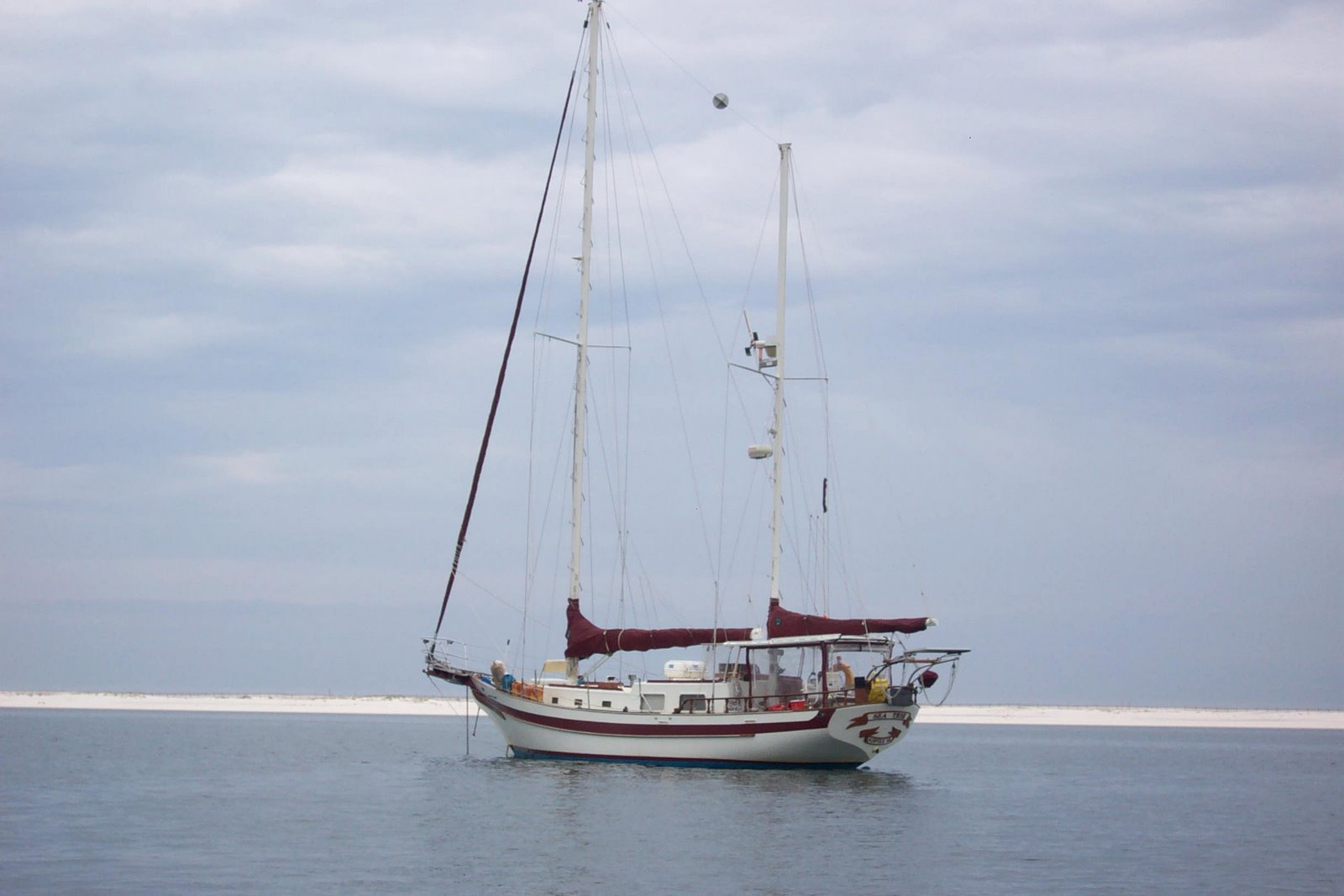 Once again we needed to head out into the Gulf because of the height of the fixed bridges along the waterway. This was another overnight for us and we left Panama City in the early afternoon and arrived in Pensacola early the next morning.
Once again we needed to head out into the Gulf because of the height of the fixed bridges along the waterway. This was another overnight for us and we left Panama City in the early afternoon and arrived in Pensacola early the next morning. Even though our runs offshore should have allowed us to do some sailing, we found the lack of wind and the direction made it necessary to motor most of the distance we covered. We were, however, pleasantly surprised with an eight-hour sail at the outset of this passage.
The entrance to Pensacola is a military and ship channel so it is deep and well-marked. There are marinas with transient slips, haul-out facilities and fuel available in Pensacola, but keep in mind they are out of the way and off the waterway. We entered the bay then continued west and anchored behind Perdido Key in Big Lagoon. We had planned our fuel stops to skip Pensacola and fuel up in Orange Beach, Ala., only about eight miles from our anchorage stop. This area is still recovering from Hurricane Ivan, two years prior, but the two main marinas directly on the GIWW in Orange Beach have been repaired and reopened with full services including a couple of great restaurants and some of the friendliest folks we have met along this route. We stayed a couple of days longer than we had planned.
From Pensacola on, the rest of our trip to Texas would keep us on the waterway and on the relatively protected inside.
 We decided to make our transit via the Gulf Intracoastal Waterway instead of a direct crossing of the Gulf of Mexico. These decisions were made after a great deal of research regarding the condition of the waterways and what facilities would or would not be available along our route.
We decided to make our transit via the Gulf Intracoastal Waterway instead of a direct crossing of the Gulf of Mexico. These decisions were made after a great deal of research regarding the condition of the waterways and what facilities would or would not be available along our route.

